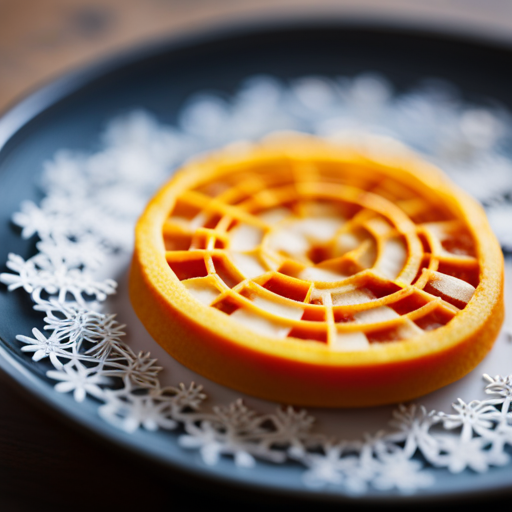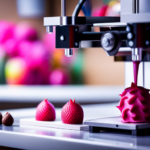In the intersection of technology and gastronomy, the emergence of 3D printed food has sparked a culinary revolution. This groundbreaking innovation challenges traditional notions of food production and consumption, offering a unique blend of texture and taste.
As we delve into the realm of 3D printed cuisine, we confront a tapestry of possibilities and complexities, from flavor enhancement to consumer acceptance.
Join us as we uncover the intricate nuances and future prospects of 3D printed food.
The Evolution of 3D Printed Food
The evolution of 3D printed food has advanced significantly in recent years, driven by technological innovations and the growing demand for personalized and sustainable food options.
Technology advancements have led to the development of 3D food printers capable of producing a wide range of edible items, from intricate chocolate sculptures to personalized nutritionally optimized meals.
Culinary artistry has embraced 3D food printing as a new medium for creativity, enabling chefs to experiment with shapes, textures, and flavors that were previously impossible to achieve using traditional methods.
These advancements have the potential to revolutionize the way food is prepared and presented, offering new possibilities for artistic expression in the culinary world.
Furthermore, 3D printed food holds promise for enhancing food sustainability. By utilizing ingredients more efficiently and reducing food waste, 3D food printing can contribute to a more sustainable food system.
Additionally, personalized nutrition through 3D printed food has the potential to address individual dietary needs, reducing overconsumption and promoting healthier eating habits.
As technology continues to advance, the evolution of 3D printed food is poised to transform the culinary landscape, offering innovative solutions to the challenges of food sustainability and personalization.
Texture and Flavor Enhancement
Advancements in 3D printing technology have opened up new possibilities for texture customization in food production. With the ability to control the structure and composition of printed food, manufacturers can offer a wide range of textures to cater to different consumer preferences.
Additionally, the infusion of enhanced flavors directly into the printed food material presents an opportunity to elevate the taste experience, providing a platform for culinary creativity and innovation.
Texture Customization Options
Customization options for texture and flavor enhancement in 3D printed food provide a unique opportunity to tailor the eating experience to individual preferences.
Customized textures allow for the creation of food with varying densities, structures, and mouthfeels, catering to different preferences and dietary needs. This can be particularly beneficial for individuals with specific texture requirements, such as those needing softer or easier-to-swallow foods.
Furthermore, flavor personalization through the incorporation of different ingredients, seasonings, and infusions enables the creation of unique taste profiles to suit diverse palates.
Enhanced Flavor Infusion
Enhanced flavor infusion in 3D printed food offers an exciting opportunity to elevate taste profiles and create unique culinary experiences. Through advanced techniques, such as micro-encapsulation and flavor layering, 3D printed food can achieve a perfect balance of flavors. This is achieved by preserving the integrity of individual ingredients, ensuring flavor preservation and compatibility.
The possibilities for enhanced flavor infusion are vast, including:
- Layering delicate fruit essence within a pastry lattice for a burst of flavor with every bite.
- Infusing savory umami notes into protein-based dishes, enhancing depth and complexity.
- Creating custom spice blends that are precisely distributed throughout the food, ensuring consistent flavor in every portion.
- Incorporating subtle hints of complementary herbs and botanicals into sauces and dressings, adding a nuanced depth of flavor.
These techniques revolutionize traditional culinary approaches, offering unprecedented control over flavor infusion and creating sensory experiences that were previously unattainable. This opens the door to a new realm of culinary creativity possibilities.
Culinary Creativity Possibilities
The potential for texture and flavor enhancement in 3D printed food opens up a new realm of culinary creativity, allowing for precise control and manipulation of sensory experiences. By customizing the presentation of food, chefs can create intricate designs and textures that were previously unattainable using traditional cooking methods. This level of customization extends to flavor infusion, where ingredients can be layered or integrated in unique ways to create novel taste experiences.
Furthermore, the ability to control the composition of food at a molecular level opens doors to enhancing nutritional benefits by incorporating specific nutrients or supplements tailored to individual needs. These advancements in 3D printed food technology provide chefs with unprecedented opportunities to explore and innovate in the culinary world, driving the evolution of gastronomic experiences.
Transitioning into the subsequent section about culinary applications and innovations, these possibilities have sparked a wave of experimentation and creativity in the food industry.
Culinary Applications and Innovations
Culinary professionals are exploring the potential of 3D printing technology to revolutionize food preparation and presentation. This innovative approach offers numerous possibilities for customized meals and sustainable production.
Some of the key culinary applications and innovations of 3D printed food include:
-
Complex Geometric Designs: 3D printing allows chefs to create intricate and visually stunning food designs that would be challenging to achieve using traditional methods. This opens up new opportunities for artistic expression and presentation in the culinary world.
-
Personalized Nutrition: With 3D printing, it becomes feasible to customize the nutritional content and portion sizes of meals according to individual dietary needs and preferences. This level of personalization could have significant implications for healthcare and wellness.
-
Alternative Ingredients: The technology enables the use of alternative ingredients such as insect-based proteins or algae, which are more sustainable and environmentally friendly. This paves the way for the creation of novel food products with reduced environmental impact.
-
Efficient Production: 3D printing streamlines the production process, leading to reduced food waste and energy consumption. This aligns with the growing emphasis on sustainability and efficient resource utilization in the culinary industry.
Challenges in 3D Printed Food
Admittedly, implementing 3D printing technology in food production remains a sporadically practiced endeavor within the culinary industry. The integration of 3D printing technology into the realm of food production introduces a myriad of challenges, particularly with regard to food safety and the intricacies of printing technology. The following table outlines some of the key challenges faced in the 3D printing of food:
| Challenges | Description |
|---|---|
| Food Safety | Ensuring that 3D printed food meets the necessary hygiene and safety standards to prevent foodborne illnesses. |
| Printing Technology | Adapting printing technology to accommodate the unique properties and textures of various food materials. |
| Taste and Texture | Maintaining the sensory qualities of 3D printed food to ensure that it is palatable and enjoyable for consumers. |
| Ingredient Selection | Identifying suitable ingredients that can be used in 3D printing without compromising the quality of the final product. |
| Regulatory Approval | Navigating the complex regulatory landscape to obtain approval for 3D printed food products for commercial distribution. |
These challenges necessitate rigorous research and development efforts to overcome the technological and regulatory hurdles associated with 3D printed food production while prioritizing consumer health and satisfaction.
Consumer Response and Acceptance
Implementing 3D printing technology in food production presents the challenge of gaining consumer acceptance and understanding their response to this innovative approach. Consumer feedback and market adoption play crucial roles in determining the success of 3D printed food.
The current consumer response and acceptance of 3D printed food can be described as follows:
-
Consumer Feedback: Understanding the preferences and concerns of consumers regarding the texture, taste, and nutritional aspects of 3D printed food is essential. Gathering feedback through surveys, taste tests, and sensory evaluations helps in identifying areas for improvement and innovation.
-
Market Adoption: Observing the rate at which 3D printed food products are being embraced by the market is pivotal. Analyzing sales data, consumer trends, and adoption rates across different demographic segments provides insights into the acceptance and potential growth of this technology in the food industry.
-
Perceived Value: Assessing how consumers perceive the value proposition of 3D printed food in terms of convenience, customization, and sustainability influences their acceptance and adoption.
-
Education and Communication: The level of awareness and understanding among consumers regarding the technology, processes, and benefits of 3D printed food significantly impacts their response and acceptance. Effective communication and educational initiatives are essential in shaping consumer perceptions and fostering acceptance.
Future of 3D Printed Food
The future of 3D printed food holds great potential for revolutionizing the culinary industry. With advancements in future technology, 3D food printing is expected to become more widespread, offering exciting possibilities for food customization. This technology will enable consumers to tailor their meals according to their specific dietary needs, preferences, and nutritional requirements. Additionally, it can open up new avenues for chefs and food manufacturers to create intricate and visually stunning dishes that were previously impossible to achieve using traditional methods. Moreover, 3D printed food has the potential to address global food security issues by providing innovative solutions for creating sustainable and nutritious meals. Embracing this future technology could lead to a paradigm shift in how food is prepared and consumed, offering endless opportunities for creativity and innovation within the culinary world.
| Future Technology | Food Customization | Culinary Innovation |
|---|---|---|
| Advanced 3D printing techniques will enable the creation of more intricate and complex food designs. | Customizing food textures, flavors, and nutritional content to cater to individual preferences and dietary requirements. | Revolutionizing traditional cooking methods and presenting new possibilities for chefs and food manufacturers to experiment with innovative dishes. |
Frequently Asked Questions
Are There Any Health Concerns Associated With Consuming 3D Printed Food?
Health concerns associated with consuming 3D printed food may include potential risks of contamination during the printing process. Additionally, the nutritional value of 3D printed food and the impact of printing materials on health warrant further study.
How Does the Cost of 3D Printed Food Compare to Traditionally Prepared Food?
When comparing the cost of 3D printed food to traditionally prepared food, it is essential to consider various factors such as material costs, production efficiency, and taste testing. This analysis provides valuable insights into the economic viability of 3D printed food.
What Are the Environmental Impacts of 3D Printed Food Production?
The environmental impact of 3D printed food production is a complex subject. While it offers potential for waste reduction, the energy consumption and materials used in the process must be carefully managed for sustainable benefits.
Can 3D Printed Food Cater to Dietary Restrictions and Preferences?
3D printed food has the potential to cater to dietary restrictions and preferences by offering customized nutrition. For instance, personalized meal plans can be created to accommodate allergies, intolerances, and specific nutritional needs, enhancing culinary creativity.
Are There Any Regulations or Standards in Place for 3D Printed Food Production and Consumption?
Regulatory compliance for 3D printed food production and consumption is a critical concern. Ensuring food safety, ethical considerations, and cultural acceptance are key factors. Establishing industry standards is essential for the responsible advancement of this technology.
Conclusion
In conclusion, the development of 3D printed food has presented exciting opportunities for enhancing texture and flavor in culinary applications.
Despite challenges in consumer acceptance, the future of 3D printed food looks promising.
According to a recent study, the global 3D food printing market is projected to reach $525.6 million by 2026, indicating a growing interest and investment in this innovative technology.


